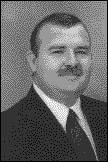v6n1pm
President’s message |
 Greetings
from south central Kentucky. I hope that your clients are surviving
low hog prices. Although money is tight, there is a greater need
for the input of swine practitioners during hard times than in
times of prosperity. The centerpiece of the AASP’s efforts to
help you stay on the leading edge has for many years been the
AASP Annual Meeting, and 1999 will be no exception. Mark your
calendars and make plans now for February 27-March 2 in St. Louis,
Missouri at the Adam’s Mark Hotel. Al Scheidt and his Planning
Committee have been hard at work putting together a meeting that
will help you help your clients.
Greetings
from south central Kentucky. I hope that your clients are surviving
low hog prices. Although money is tight, there is a greater need
for the input of swine practitioners during hard times than in
times of prosperity. The centerpiece of the AASP’s efforts to
help you stay on the leading edge has for many years been the
AASP Annual Meeting, and 1999 will be no exception. Mark your
calendars and make plans now for February 27-March 2 in St. Louis,
Missouri at the Adam’s Mark Hotel. Al Scheidt and his Planning
Committee have been hard at work putting together a meeting that
will help you help your clients.
The theme for the meeting is "Swine Practice, Pork, and the Media." We will again provide pre-conference workshops on a variety of topics on Saturday afternoon and Sunday morning. Concurrent sessions on Sunday afternoon include three industrial partners’ sessions and the student seminars. The Monday morning general session will examine the thematic topics, featuring the Howard Dunne memorial lecture by Larry Rueff. The Monday afternoon general session will focus on classical swine fever (hog cholera) and porcine reproductive and respiratory syndrome (PRRS). Tuesday’s concurrent sessions will address three areas that are sure to generate high interest: "Vaccinology and Serology" (this has been a highly successful preconference workshop for the past 2 years and has been moved to the main meeting because of the interest level and positive feedback from participants), "Research Topics," and "Swine Practice Potpourri." I urge you to join your fellow members in St. Louis for a good time and a great meeting.
On July 31, your AASP Foundation Board of Directors met in Omaha, Nebraska for a planning session. Foundation President Conrad Schmidt and the rest of the Board have planned several activities as part of "Campaign 2000." Several fund-raising activities are being put together to occur between now and the year 2000 AASP Annual Meeting, as well as at the meeting itself. You will be hearing more from Connie and the Foundation about these. If you are not already a Leman Fellow (currently there are 45), you can become one by investing $1000 in your Foundation, or pledging that amount over the next 5 years. The Leman Fellows Program will become the centerpiece of an endowed fund to be generated by Campaign 2000. The principal of the fund will remain intact and the interest will be used to accomplish the mission of the Foundation. The Foundation’s assets have hovered at around $40,000 for several years, with revenues (donations) approximately equal to operational expenses and project awards. This has been enough to sponsor one to two significant projects per year, but has not allowed the Foundation to expand in a major way. The Foundation Board of Directors has determined that the best way to grow the Foundation in a way that meets the needs of the next several years is to create an endowed fund based on the Leman Fellows Program.
In order to make Campaign 2000 work we need 300 Leman Fellows by 2000. Surely there are enough AASP members who have benefited from our profession and our organization who are committed enough to the future of the organization to surpass this goal.
In addition to Campaign 2000, the Foundation Board has been working hard in conjunction with Elanco Animal Health to make the Elanco Veterinary Student Scholarship Program available to students interested in swine health and production. Elanco has granted the Foundation $10,000 to be used for five scholarships of $2000 each. The plan is to select four veterinary students and one graduate student for these awards. John Deen will chair the selection committee for these awards.
I recently had the opportunity to represent the AASP by attending a portion of the American Association of Bovine Practitioners (AABP) meeting. It was interesting to observe their activities, look at their program book, and sit in on a couple of their sessions. As I noted in my short address at their awards luncheon, we have many areas of common interest. We have worked together on many of these issues in the past, are doing so currently, and need to do a better job of working together in the future. The shared issues of antimicrobial resistance, food safety and quality, commodity prices, and practice economics quickly come to mind. One interesting item where we could perhaps learn from them: their membership of about 5700 includes 800 plus students (15%); our membership of about 1700 includes around 150 students (8%). What are they doing, or what are their characteristics, that makes them apparently more attractive to student members?
Your colleagues on the many active committees in the AASP are working hard to serve the membership. I’m sure they would appreciate volunteer help and any input you might have. By the time you read this message the annual Fall Board meeting will have taken place. I’ll report on actions taken there next time.